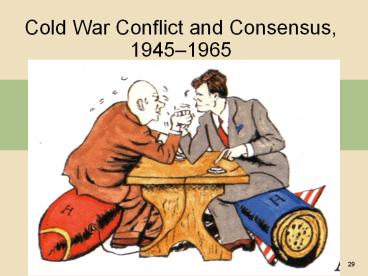Cold War Conflict and Consensus, 1945 - PowerPoint PPT Presentation
Title: Cold War Conflict and Consensus, 1945
1
- Cold War Conflict and Consensus, 19451965
29
2
- I. Postwar Europe and the Origins of the Cold War
- A. The Legacies of the Second World War
- 1. Physical Destruction
- 2. Death Tolls
- 3. Displaced Persons (DPs) and the Homeless
- 4. War Crimes
3
(No Transcript)
4
- I. Postwar Europe and the Origins of the Cold War
- B. The Peace Accords and Cold War Origins
- 1. Early Discussions
- 2. The Tehran Conference (November 1943)
- 3. The Yalta Conference (February 1945)
- 4. The Breakdown of Yalta
5
- I. Postwar Europe and the Origins of the Cold War
- C. West Versus East
- 1. Rising Antagonisms
- 2. The Truman Doctrine
- 3. The Marshall Plan
- 4. The Berlin Blockade
- 5. NATO and the Warsaw Pact
- 6. The Cold War in Asia
6
(No Transcript)
7
- I. Postwar Europe and the Origins of the Cold War
- D. Big Science and New Technologies
- 1. Applied Science in WWII
- 2. Big Science
- 3. Achievements
8
(No Transcript)
9
- II. The Western Renaissance
- A. The Search for Political and Social Consensus
- 1. The Postwar Economic Boom
- 2. Christian Democratic Parties
- 3. The Labour Party
- B. Toward European Unity
- 1. Early Steps Towards Unity
- 2. European Coal and Steel Community (1951)
- 3. The European Economic Community
10
- II. The Western Renaissance
- C. The Consumer Revolution
- 1. The Postwar Boom
- 2. The Cold War Context
11
- III. Soviet Eastern Europe
- A. Postwar Life Under Stalin
- 1. The Return to Dictatorship
- 2. Stalinization in Eastern Europe
- 3. Establishing Command Economies
- 4. Censorship and Opposition
12
- III. Soviet Eastern Europe
- B. Reform and De-Stalinization
- 1. The Death of Stalin (1953)
- 2. Nikita Khrushchev (18941971)
- 3. Destalinization
- 4. Boris Pasternak (18901960)
- 5. Aleksandr Solzhenitsyn (19182008)
13
- III. Soviet Eastern Europe
- C. Foreign Policy and Domestic Rebellion
- 1. Peaceful Coexistence
- 2. Reform in Poland
- 3. The Hungarian Revolt (1956)
- D. The Limits of Reform
- 1. The Berlin Crises
- 2. The Cuban Missile Crisis (1962)
- 3. Leonid Brezhnev (19061982)
14
- IV. The End of Empires
- A. Decolonization and the Cold War
- 1. Imperial Collapse
- 2. The Impact of the Cold War
- 3. Nonalignment
15
(No Transcript)
16
- IV. The End of Empires
- B. The Struggle for Power in Asia
- 1. Indonesia
- 2. French Indochina
- 3. India
- 4. China
17
- IV. The End of Empires
- C. Independence and Conflict in the Middle East
- 1. The Arab-Israeli Conflict
- 2. Gamel Abdel Nasser (19181970)
- 3. The Suez Crisis (1956)
18
- IV. The End of Empires
- D. The African Awakening
- 1. British Colonies
- 2. The Belgian Congo
- 3. French Colonies
- 4. The Algerian War
- 5. Continued European Presence
19
- V. Postwar Social Transformations
- A. Changing Class Structures
- 1. The Middle Class
- 2. Class Leveling in the East
- 3. The Lower Classes
20
- V. Postwar Social Transformations
- B. Patterns of Postwar Migration
- 1. Migration Within National Borders
- 2. Migration from South to North
- 3. Postcolonial Migration
- 4. Tensions
21
- V. Postwar Social Transformations
- C. New Roles for Women
- 1. Declining Birthrates
- 2. The Workplace
- 3. Challenges
- D. Youth Culture and the Generation Gap
- 1.Youth Cultures
- 2. Consumption
- 3. Higher Education

